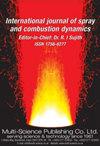Long-term carbon monoxide emission behavior of heavy-duty gas turbines: An approach for model-based monitoring and diagnostics
IF 2.1
4区 工程技术
Q3 ENGINEERING, MECHANICAL
International Journal of Spray and Combustion Dynamics
Pub Date : 2018-08-31
DOI:10.1177/1756827718791921
引用次数: 1
Abstract
Emission measurements are a valuable source of information regarding the condition of gas turbine combustors. Aging of the hot gas path components can lead to an emission increase, which may ultimately require a readjustment of operational settings and accordingly impacts plant availability and maintenance. While NOx emissions may become crucial in high flame temperatures at full load, carbon monoxide emissions typically restrict low-load operation, which electricity markets demand more frequently due to the increasing penetration of intermittent renewable power. This paper presents a semiempirical carbon monoxide model that allows for quantifying the evolution of carbon monoxide emissions for GT24/GT26 heavy-duty gas turbines in commercial long-term operation. Input parameters to the derived carbon monoxide model are either directly measured or reconstructed by virtual measurements based on a simplified engine model. The method is developed with commissioning and operation data of three different gas turbines of GE’s GT24/GT26 fleet and validated over a total of 8.5 years of observation. Aging is accounted for by incorporating control sensor deviation and the formation of cold spots in the combustor into the semiempirical model. When these effects are taken into account, the carbon monoxide prediction is improved by up to 60% in terms of root mean square error of the log10(carbon monoxide) values compared to a benchmark case without consideration of aging.重型燃气轮机的长期一氧化碳排放行为:一种基于模型的监测和诊断方法
排放测量是有关燃气轮机燃烧器状况的有价值的信息来源。热气通道组件的老化可能导致排放增加,最终可能需要重新调整操作设置,并相应地影响工厂的可用性和维护。虽然NOx排放在满负荷的高火焰温度下可能变得至关重要,但一氧化碳排放通常会限制低负荷运行,由于间歇性可再生能源的普及,电力市场更频繁地要求低负荷运行。本文提出了一个半经验一氧化碳模型,用于量化GT24/GT26重型燃气轮机在商业长期运行中一氧化碳排放的演变。导出的一氧化碳模型的输入参数要么直接测量,要么基于简化的发动机模型通过虚拟测量重建。该方法是根据通用电气GT24/GT26机队的三台不同燃气轮机的调试和运行数据开发的,并经过8.5年的观测验证。通过将控制传感器偏差和燃烧器中冷斑的形成纳入半经验模型来说明老化。当考虑到这些影响时,与不考虑老化的基准情况相比,就log10(一氧化碳)值的均方根误差而言,一氧化碳预测提高了高达60%。
本文章由计算机程序翻译,如有差异,请以英文原文为准。
求助全文
约1分钟内获得全文
求助全文
来源期刊

International Journal of Spray and Combustion Dynamics
THERMODYNAMICS-ENGINEERING, MECHANICAL
CiteScore
2.20
自引率
12.50%
发文量
21
审稿时长
>12 weeks
期刊介绍:
International Journal of Spray and Combustion Dynamics is a peer-reviewed open access journal on fundamental and applied research in combustion and spray dynamics. Fundamental topics include advances in understanding unsteady combustion, combustion instability and noise, flame-acoustic interaction and its active and passive control, duct acoustics...
 求助内容:
求助内容: 应助结果提醒方式:
应助结果提醒方式:


